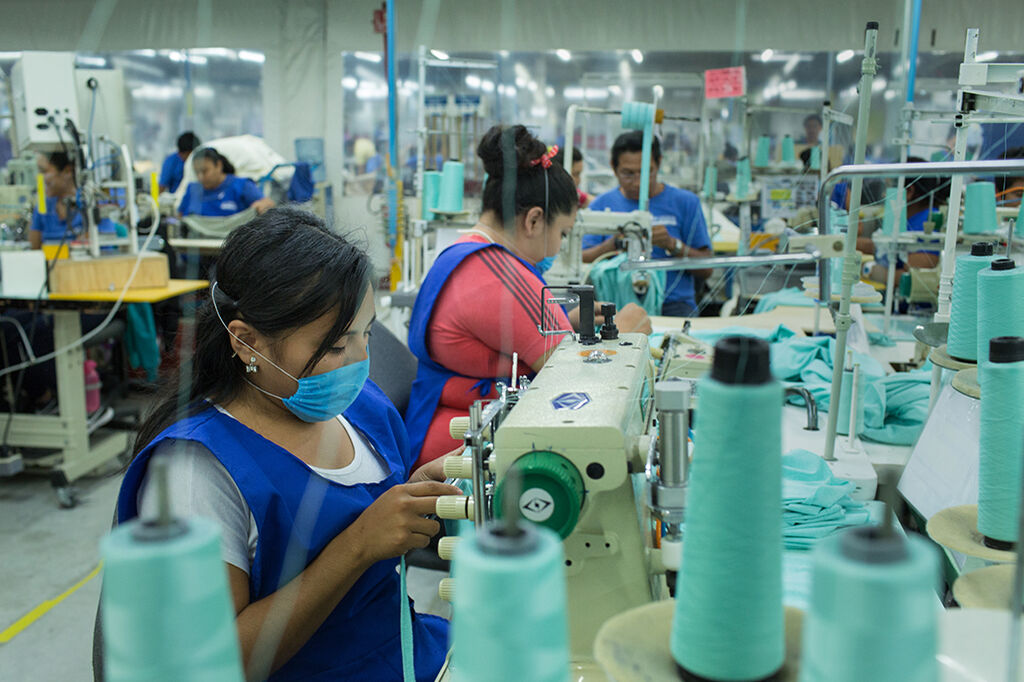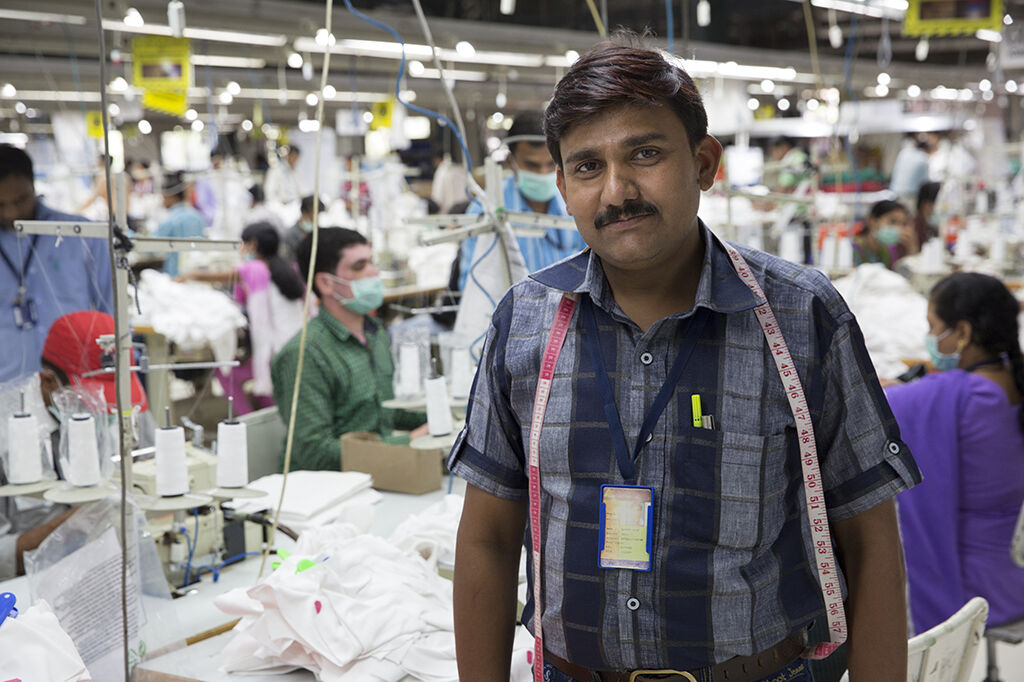Fair trade coffee and fair trade chocolate has been widely recognized and accepted. But what about responsible apparel sourcing?
Ten years ago, Fair Trade USA started working with fashion and outdoor brands to encourage a deeper commitment to their manufacturers. The philosophy is the same: bringing transparency, accountability, and equity to a supply chain. But the approach is slightly different, catering to the needs of the vast, and rapidly growing apparel industry.
Our affinity for clothes has been increasing. In America, clothing consumption has doubled in the past 15 years. We’re buying more and wearing each article of clothing for a shorter time. It’s a systemic problem driven by cheap, and often, unethical labor.
While some progress had been made to measure and reduce the ecological impact of production, the industry needed a comprehensive factory framework that set or enforced ethical and safe working conditions. That’s why we set out to create the blueprint of a fair trade factory starting with a pilot in 2010. Today, the Fair Trade USA program focuses on the details of a factory operation: how workers are paid, what conditions they work in, what support they receive in times of need, and what measures they are taking to improve their environmental practices with time. It gives credibility to how our clothes are made.
Our Factory Program includes not just clothes but also home goods like textiles, bedding, and furniture. Currently, 67 brands offer Fair Trade Certified apparel and home goods, sourcing from 90 factories globally to promote the well-being of factory workers.
To be certified, a factory has to agree and comply with a host of business practices. These range from saying no to child labor, paying fair wages (including overtime, if needed), having hospitable and safe working environments for workers, and supporting workers beyond their day job itself. When consumers buy a Fair Trade Certified garment for their wardrobe or new linens for their bedroom, they’re supporting a fairer economic model that gives workers a safer workplace and more autonomy in their lives and communities.
Demands of modern markets and globalization have connected us all but we are more disconnected from the manufacturing process than ever before. When you buy a dress, you don’t know about the challenges the garment worker faced that day getting to work, finding someone to look after her young child, or if she was working in dismal conditions. The human element of manufacturing has been replaced by names of countries on our tags, and at most, names of factories. But our clothes are still made by people, not machines.
The fair trade model celebrates them as individuals, brings their story back into the process, and aspires to build a new type of supply chain that respects the many faces who make it feasible.

Employees at Vertical Knits, a Fair Trade Certified factory in Yucatan, Mexico, assemble t-shirts.
The Pandemic Effect
This humanity of manufacturing came to light last year. The pandemic illustrated the challenges that continue to rattle the fashion industry and leave garment workers with little to no protections or assurances in the conventional system. In contrast, many brands that work with fair trade factories were able to support apparel workers in this chaotic period. The fair trade model kicked in for certified factories: a Community Development Fund, dedicated to the needs of the workers, be it health, educational, or otherwise, offered emergency funds to thousands of apparel workers.
The model works like this: for each Fair Trade Certified product sold, the business, brands such as Madewell, Arc’teryx, prAna, and more, pay above the purchase price of the goods. Those additional funds are then transferred to workers through the official Community Development Fund. How these funds are spent is up to the workers themselves. Through a fair trade committee structure at each facility, workers organize and democratically vote on the allocation of the money. In fact, the workers set up a bank account and manage the funds themselves. It doesn’t go through the hands of a manager. It’s as direct as possible. In 2019, before the pandemic, this feature enabled more than $8 million to be sent to over 100,000 workers at fair trade certified facilities.
So as the pandemic put a pause on production, Fair Trade Committees were able to prioritize those funds to provide pre-paid grocery cards to their workers, sanitation and hygiene supplies, and other essentials. The Community Development Fund became an invaluable resource, one that was built into the fair trade model, and thus, could be adapted quickly and efficiently to the crisis at hand.
For instance, in Vietnam, Saitex, a Fair Trade Certified facility famous for its innovations in denim manufacturing, had to make adjustments to working hours for over 4,000 employees. With American and European markets dealing with the financial turmoil of the pandemic, orders started to slow down in spring 2020. That shortened work schedules for factory workers. Since their incomes would be affected, Saitex’s fair trade committee voted to use its Community Development Fund to issue e-cash vouchers. In 2020, workers who had been at the company for at least six months received a total of 2,000,000 Vietnamese dong.
“Security is what people appreciate, knowing that they’ll have income, work, and be taken care of,” says Sanjeev Bahl, CEO of Saitex. “Secure environments breed positive thinking.”
In 2018, Madewell and Saitex joined forces in a pilot program: the Vietnamese manufacturer would be the first Fair Trade Certified facility in Madewell’s supply chain. In March 2020, Madewell extended that commitment, stating that it will have 90 percent (or more) of its denim as Fair Trade Certified by 2025.
“It’s a partnership that will stand for the long run, something we are very proud of. It has a real impact on the ground,” says Gonzalo Pertile, Director, Corporate Social Responsibility, at Madewell.
It’s this tangible impact that encouraged Canadian outdoor brand Arc’teryx into pursuing fair trade certification as well.
“I had been looking at fair trade for a while and was exploring which options would allow us to provide funds directly to the people who make our clothes. Fair trade was the solution that really works on this front.” For us, ensuring the wellbeing of those who make our product is the minimum bar for doing business,” says Adrianne Gilbride, Supply Chain Sustainability Lead at Arc’teryx.
Last year, the company committed to having 80 percent of its clothing sourced from Fair Trade Certified facilities by 2025.
“The pandemic revealed massive global imbalances and reiterated how few social protections exist for garment makers worldwide, 75 percent of who are women and whose families depend on them and this industry,” says Gilbride.
These women, much like working women anywhere else in the world, need support as they go through pregnancy, juggle raising children with a full-time job and look after the health and well-being of their families. At Saitex, the Fair Trade Committee decided to use its premiums towards healthcare, particularly for women who are expecting mothers. In Vietnam, Nguyen Trong Hoang, Saitex’s Fair Trade Officer, explains that the employer is responsible for their workers’ healthcare. Yet, when women are expecting, they have added costs for additional medical exams or treatments that would have been out-of-pocket expenses. To ensure they have a safe and comfortable pregnancy, followed by sufficient neonatal care for the newborn, Saitex has devoted these funds to 58 percent of its workforce who are women.
“There are very few ways for brands to actually get money directly into the hands of workers which is why this certification is so helpful,” notes Gilbride.

Ranjit Singh, a tailor at Pratibha Syntex, a Fair Trade Certified factory in Pithampur, India.
The Future of Responsible Apparel Sourcing
Consumers are also looking for this kind of commitment and support from apparel companies. And they’re expressing these views through their purchases. The market for goods made sustainably is estimated to be at $150 billion this year, and growing at a rate of 8 percent, compared to the industry average of 2.6 percent. The treatment of workers in a supply chain is integral to today’s shoppers; more than two-thirds of consumers said they would actually stop buying, or reduce their purchases, from companies that don’t treat workers fairly (source).
Arc’teryx noticed that its consumers were asking more questions about how the products were made and by whom in recent years. “In the last two years, we have really seen much more interest in the people component of our business and our supply chains,” says Gilbride.
Similarly, Bahl who has been in apparel manufacturing for over 20 years, notes that he sees a shift in young buyers who are asking pivotal questions of where and how their clothes are made. “This next-generation gives me hope.”
This bottom-up demand is growing each year, suggesting that so-called “sustainability,” which includes people, is not a trend, but the future. Thus, brands that make long-term commitments to their manufacturers can only deepen their impact. And it’s over years, not months, that changes are materialized.
“Companies need to think about how they’re going to work with a supplier for years, not seasons,” says Gilbride. “If you’re thinking about fair trade certification, that’s great, but it’s a model for the long-term.”
Similarly for fair trade manufacturers, by prescribing to ethical business practices, they’re also likely to see higher retention rates at their facilities. Resources invested in workers will keep them coming back to a factory where they’re heard and respected. “That’s fundamentally what people want. They want to be seen, acknowledged, and appreciated.”
For Madewell, working with Fair Trade USA, enabled the company to keep its sustainability team lean, yet still achieve its goals. Companies that are liaising with several brands, across various territories, it makes more sense, Pertile argues, to work with a third-party such as Fair Trade USA than to build one’s impact program and criteria.
Brands, such as Madewell and Arc’teryx, which have made public commitments to fair trade, are now keen to push for industry-wide changes. “We are open and transparent in how we share our process,” says Pertile.
Collective action across the industry is how fair trade will become the norm, not the exception. With forward-thinking brands who are interested in the overall well-being of the apparel industry, change is possible, says Bahl. “Such brands are contributing to the growth of the next generation. They’re not short-term thinkers, they’re long-term value creators.”